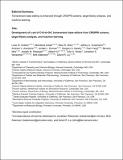| dc.contributor.author | Koblan, Luke W. | |
| dc.contributor.author | Arbab, Mandana | |
| dc.contributor.author | Shen, Max Walt | |
| dc.contributor.author | Hussmann, Jeffrey A. | |
| dc.contributor.author | Anzalone, Andrew V. | |
| dc.contributor.author | Doman, Jordan L | |
| dc.contributor.author | Newby, Gregory Arthur | |
| dc.contributor.author | Yang, Dian | |
| dc.contributor.author | Mok, Beverly | |
| dc.contributor.author | Replogle, Joseph M. | |
| dc.contributor.author | Xu, Albert | |
| dc.contributor.author | Sisley, Tyler A. | |
| dc.contributor.author | Weissman, Jonathan S. | |
| dc.contributor.author | Adamson, Britt | |
| dc.contributor.author | Liu, David R. | |
| dc.date.accessioned | 2021-08-24T20:39:03Z | |
| dc.date.available | 2021-08-24T20:39:03Z | |
| dc.date.issued | 2021-06 | |
| dc.date.submitted | 2021-01 | |
| dc.identifier.issn | 1087-0156 | |
| dc.identifier.issn | 1546-1696 | |
| dc.identifier.uri | https://hdl.handle.net/1721.1/131196 | |
| dc.description.abstract | Programmable C•G-to-G•C base editors (CGBEs) have broad scientific and therapeutic potential, but their editing outcomes have proved difficult to predict and their editing efficiency and product purity are often low. We describe a suite of engineered CGBEs paired with machine learning models to enable efficient, high-purity C•G-to-G•C base editing. We performed a CRISPR interference (CRISPRi) screen targeting DNA repair genes to identify factors that affect C•G-to-G•C editing outcomes and used these insights to develop CGBEs with diverse editing profiles. We characterized ten promising CGBEs on a library of 10,638 genomically integrated target sites in mammalian cells and trained machine learning models that accurately predict the purity and yield of editing outcomes (R = 0.90) using these data. These CGBEs enable correction to the wild-type coding sequence of 546 disease-related transversion single-nucleotide variants (SNVs) with >90% precision (mean 96%) and up to 70% efficiency (mean 14%). Computational prediction of optimal CGBE-single-guide RNA pairs enables high-purity transversion base editing at over fourfold more target sites than achieved using any single CGBE variant. | en_US |
| dc.description.sponsorship | US NIH (Grants F31NS115380, U01AI142756, UG3AI150551, RM1HG009490, R35GM118062, R35GM138167 and P30CA072720) | en_US |
| dc.language.iso | en | |
| dc.publisher | Springer Science and Business Media LLC | en_US |
| dc.relation.isversionof | http://dx.doi.org/10.1038/s41587-021-00938-z | en_US |
| dc.rights | Creative Commons Attribution-Noncommercial-Share Alike | en_US |
| dc.rights.uri | http://creativecommons.org/licenses/by-nc-sa/4.0/ | en_US |
| dc.source | Luke Koblan | en_US |
| dc.title | Development of a set of C•G-to-G•C transversion base editors from CRISPRi screens, target-library analysis, and machine learning | en_US |
| dc.title.alternative | Efficient C•G-to-G•C base editors developed using CRISPRi screens, target-library analysis, and machine learning | en_US |
| dc.type | Article | en_US |
| dc.identifier.citation | Koblan, Luke W. et al. "Development of a set of C•G-to-G•C transversion base editors from CRISPRi screens,
target-library analysis, and machine learning." Nature Biotechnology (June 2021): dx.doi.org/10.1038/s41587-021-00938-z. © 2021 The Author(s) | en_US |
| dc.contributor.department | Massachusetts Institute of Technology. Department of Biology | en_US |
| dc.contributor.department | Massachusetts Institute of Technology. Department of Chemistry | en_US |
| dc.contributor.department | Massachusetts Institute of Technology. Computational and Systems Biology Program | en_US |
| dc.relation.journal | Nature Biotechnology | en_US |
| dc.eprint.version | Author's final manuscript | en_US |
| dc.type.uri | http://purl.org/eprint/type/JournalArticle | en_US |
| eprint.status | http://purl.org/eprint/status/PeerReviewed | en_US |
| dc.date.updated | 2021-08-09T14:23:02Z | |
| dspace.orderedauthors | Koblan, LW; Arbab, M; Shen, MW; Hussmann, JA; Anzalone, AV; Doman, JL; Newby, GA; Yang, D; Mok, B; Replogle, JM; Xu, A; Sisley, TA; Weissman, JS; Adamson, B; Liu, DR | en_US |
| dspace.date.submission | 2021-08-09T14:23:06Z | |
| mit.license | OPEN_ACCESS_POLICY | |
| mit.metadata.status | Complete | |
